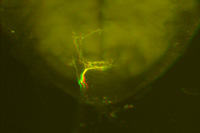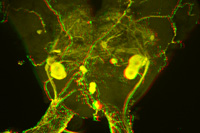 Bev Mitchell, Professor
[bev.mitchell@ualberta.ca]
Bev Mitchell, Professor
[bev.mitchell@ualberta.ca]Department of Biological Sciences
 Bev Mitchell, Professor
[bev.mitchell@ualberta.ca]
Bev Mitchell, Professor
[bev.mitchell@ualberta.ca]
Academic degrees
 |
 |
Flesh fly SOG Left, taste projection Right, 5-HT immunoreactive cells
Chemosensory systems in insects.
Chemosensory systems allow organisms to differentially sense and respond to external and internal chemical changes. In insects, both taste and smell are essential for behaviours such as food finding and feeding, egg laying, host acceptance, mate finding, and threat avoidance.
My work focuses on the taste system in the sarcophagid flesh fly Neobellaria bullata. Flesh flies are scavengers, often arriving early at dead carcasses. Consequently they are particularly important as forensic indicators. They can be serious pests especially where meat and fish are displayed in open markets. Some sarcophagids are also important and insufficiently studied parasitoids of economically important insects such as the forest tent caterpillar. Because they frequent newly killed vertebrates, they are potentially important in disease transmission. Increased knowledge of the taste system of flesh flies, especially since we have shown that taste is essential to larviposition site selection, could have major benefits.
We already have good knowledge of larviposition (egg laying) behaviour and taste receptor physiology in large flies like N. bullata. However, our understanding of the taste stimuli involved and of the way that taste input is processed in the central nervous system is very limited. Our current research addresses these questions. To understand taste stimuli and their effects we use a combination of chemical analysis with behavioural and sensory physiological experimentation. To understand central processing of taste we integrate three approaches to answer three highly related general questions; neurophysiology (how is cellular communication accomplished functionally), neuroanatomy (what is the spatial relationship among the cellular components and how does this serve function), neuromodulation (how do specific, internally derived chemicals modify activity in neural circuits). This is one of the very few projects in the world to focus on central nervous aspects of insect taste.
Projects are available on neurophysiology (peripheral and central), neuroanatomy and immunocytochemistry (biogenic amines). The flesh fly subeosophageal ganglion will be the focal point of these studies. Applications from prospective M.Sc. or Ph.D. students are welcome. We are well equipped for sensory recording and associated computer analysis, interneuron recording, back-filling for neuroanatomy, immunocytochemistry of biogenic amines, fluorescence microscopy with confocal reconstruction and digital image processing.
| Biology 108 | Intro. Ent. Multimedia Project |
| Entomology 207 Agricultural Entomology | Bio-DiTRL |
| Entomology 321 Insect Function | Acrobat and the busy Professor |
| Biology 620 Graduate Core | Entomology 521 |
Teaching and Technology Involvement
| Department Learning Initiatives Committee (Member) |
| Digital Teaching Resources Laboratory – DiTRL (Director) |
| Biology Digital Teaching Resources Library – Bio-DiTRL (Editor) |
| Information Resources and Technology Advisory Council-IRTAC (Member) |
| Academic Technologies for Learning (ATLAC) Advisory Committee (Member) |
Professional Memberships
| Association for Chemoreception Sciences | Entomological Society of Canada |
| Canadian Society of Zoologists | Society for Neuroscience |
| Entomological Society of Alberta | International Society for Chemical Ecology |
| Entomological Society of America |
You are visitor
number 
You can see the last 20 users
Last update February 11, 2000